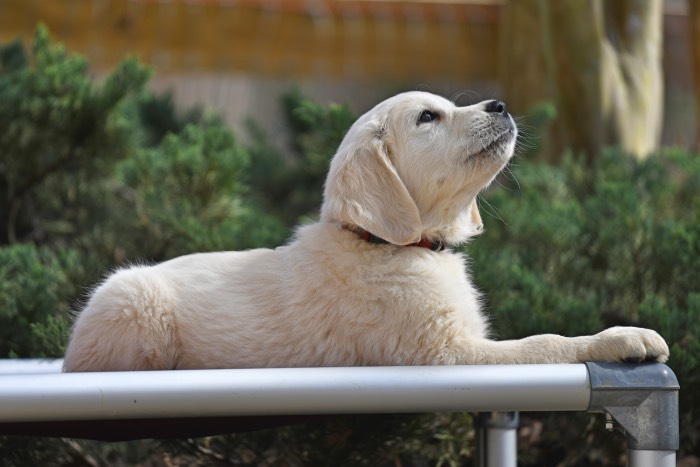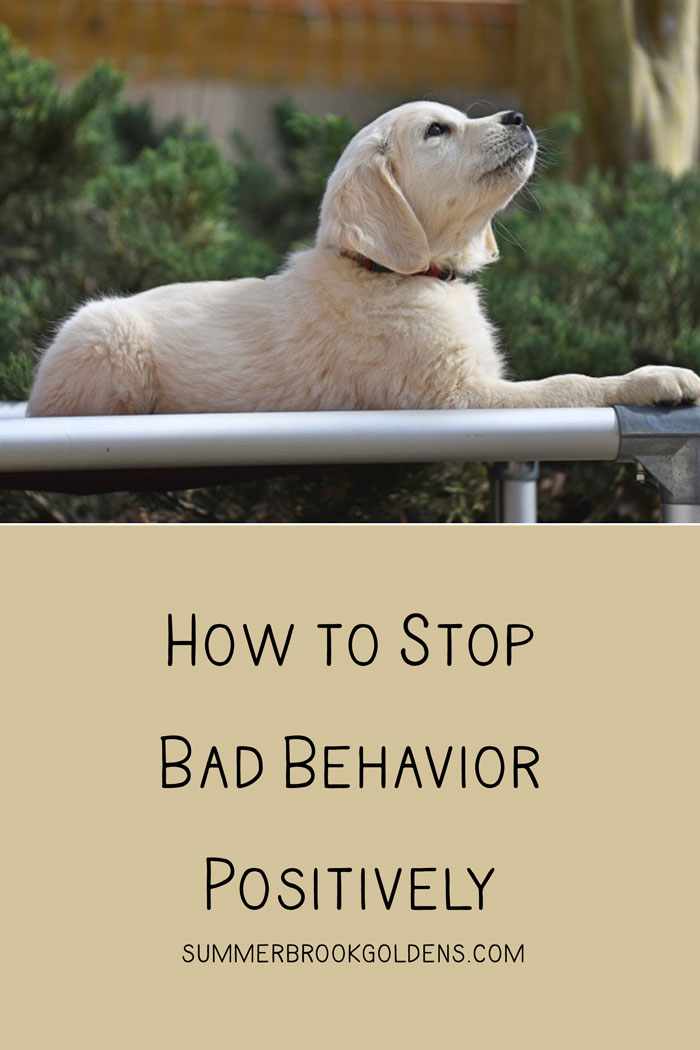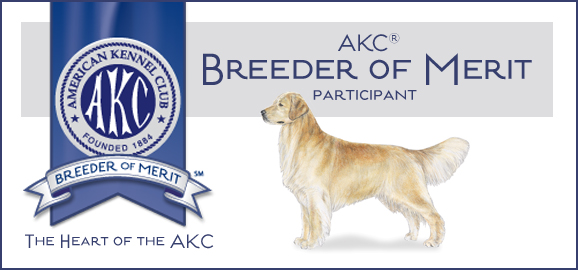Punishments are not the only way to stop bad dog behavior! There are at least five training techniques for handling bad behavior other than positive punishments. Without these five techniques, positive reinforcement training would not be possible. You can’t train good behavior while the dog is practicing bad behavior at the same time. You must stop the bad before you can train the good. However, you CAN stop bad behavior positively!

Difference Between Positive and Negative Punishments
I want to start this discussion by differentiating between positive and negative punishments.
Positive Punishments
Positive punishments are the type punishments that typically come to mind when you hear about punishments in dog training. As in math, the scientific definition of the word positive is to add something to the equation. This applies to dog training as well. The scientific definition of the word punishment is anything that makes a behavior less likely to be repeated. Therefore, a positive punishment is something added to the dog making a behavior less likely to be repeated.
If you were going to use a positive punishments, you might be using leash corrections or alpha rolls. Any painful consequence that someone could apply to a dog would be a positive punishment. Positive punishments also include non-painful, but unpleasant consequences. Even saying a calm “no” to a dog could be considered a positive punishment. Dogs that have been conditioned to hearing the word “no” to indicate wrong behavior don’t like to hear it.
Negative Punishments
There are also negative punishments. These punishments are those that involve taking something away from the dog that he likes. Just like in math, negative in dog training means taking away something. Again, the definition of a punishment is anything making a behavior less likely to be repeated. Therefore, a negative punishment would be taking something away from a dog in order to decrease the likelihood of a behavior being repeated.
An example of a negative punishment would be to leave the room when your dog jumps on you. What you are taking away from the dog is YOU. Another example would be to stop petting a puppy who is mouthy. In this example, you are taking away the puppy’s opportunity for petting. A third example would be time-outs from a fun activity where you are taking away the puppy’s chance for the fun activity.
The official scientific name, negative punishments, does not sound like a positive-only technique. However, in spite of its name, negative punishments are actually a very positive training method! Taking away something that a dog values is a very good way to stop bad behavior positively.
Control
The most commonly used technique used with almost all reward based trainers is control. Training with positive reinforcement takes time. A controlled environment gives you that time.
However, control is not the ultimate goal. Rather, it is a temporary means of keeping a puppy (or dog) from practicing poor behavior. Then, you can train an alternative good behavior. Eventually, this alternative behavior will be of higher value to the dog than the bad behavior. At this point, the puppy will choose the new more appropriate behavior over the old one.
For instance, if a puppy is chewing your shoes, you can change the environment in one of two ways. You can move the shoes or you can move the puppy. Change the environment to where the puppy no longer has the option of chewing the shoe. Then train him to enjoy chewing something else with positive reinforcement. With enough reinforcement, the toy will become more valuable than the shoe. The puppy will no longer want the shoe.
Another example of using control is the use of pens and crates. Confinement is an integral part of training with positive reinforcement. Pens and crates keep a puppy from developing bad habits while you train good habits.
Control the puppy and his environment in such a way that bad behaviors are not possible. Then training with positive enforcement will change the dog to enjoy a new, more acceptable behavior. Eventually, the new behavior will replace the bad behavior. Control gives you an opportunity to stop bad behavior positively without using punishments.
Diversion
Diversion is another good option for stopping poor behavior. Redirect the puppy to other acceptable options and he will often forget about the undesirable behavior.
Let’s take the same example with a puppy chewing a shoe (or chewing your hand). Divert a puppy’s attention from chewing the object that you don’t want him chewing. Show your puppy a more interesting toy. Make almost any toy move and be active. It will become more enticing than a shoe.
When using diversion, make sure the new behavior is more rewarding than the old one. Then the old behavior will fade away. Diversion is another excellent way to stop bad behavior positively.
Extinction
A third scientific principle of dog training is that any behavior that goes unrewarded for long enough will disappear. This principle is called the principle of extinguishment. The dog will quit the unrewarded behavior as another behavior becomes more rewarding.
Sometimes doing nothing is the best approach as long as the dog is not being inadvertently rewarded for the behavior. This inadvertent rewarding of poor behaviors is what happens with a group of behaviors called self-rewarding behaviors.
Self-rewarding behaviors present a problem with regard to extinguishment. These behaviors are the most difficult behaviors to stop with positive reinforcement techniques alone. In fact, most traditional and balanced trainers claim that these self-rewarding behaviors cannot be stopped without punishments at all. We disagree.
However, you must give special consideration to these behaviors. They do present a challenge. Self-rewarding behaviors can be handled positively, but they require more work. Check back in the next few weeks to see our upcoming post on Self Rewarding Behaviors. This post will give information on what these behaviors are. It will give examples and will have tips on how to stop these difficult behaviors.
Permissiveness and Behavior Management
The fourth way of handling poor behavior is with permissiveness. Many positive only trainers give up on training and resort far too often to permissiveness. This type training is what has given reward-based training a bad name, especially by many “balanced” and traditional trainers. We never recommend permissiveness.
Many “Positive Only” trainers advocate for managing poor behaviors instead of stopping them. They teach families how to live with these unwanted behaviors in the most tolerable way possible.
An example of this would be in the use of top clip halters with some dogs. Top clip halters are designed to give control, not to train. The dog still pulls, but the person has an easier time controlling the dog. If you don’t want to actually train a difficult dog to stop pulling on a leash, this is an acceptable option. However, for many dogs, this option is essentially a decision to give up on training. We would rather train a better behavior than to indefinitely control a poor one.
We are currently writing a series of articles on leash pulling. There will be an entire page on the use of top clip halters alone.
Can Punishments Be an Option?
We recommend non-painful punishments before we recommend permissiveness. However, punishments should only be a last resort for when diversion and control aren’t working.
Further, punishments should only be used when very specific guidelines are followed. See our page on Punishment Guidelines (to be posted soon) for more information. Punishments are never the only option. However, we acknowledge that some people are unable to curtail certain behaviors without resorting to either punishments or permissiveness.
Final Thoughts
The optimum way to handle bad behaviors is to train better alternatives. See our page on How to Use Positive Reinforcement in dog training to learn how to train better alternatives. The better alternative must have a higher value to the dog than the poor behavior. You can build value into any behavior if you reward it enough. Frequent rewards condition a dog to associate good things with behaviors thereby increasing the value of that behavior.
Until the new behavior has been trained, there are 4 valuable tools for stopping bad behavior without using positive punishment. After stopping bad behavior, you can build value into a new behavior. These 4 tools are negative punishment, control, diversion, and extinction. With these tools and positive reinforcement training for an alternative behavior, you can stop bad behavior positively!
Punishments should be used only as a last result. Only use them in cases where you are unable to be successful with positive techniques. Punishments should never become your primary training tool. You should only use them when following very strict guidelines.
Permissiveness is never an option for us. Neither is long-term management of bad behaviors. We prefer training good behaviors that replace the bad. Otherwise, a person must control and manage the bad behavior for the life of the dog.


